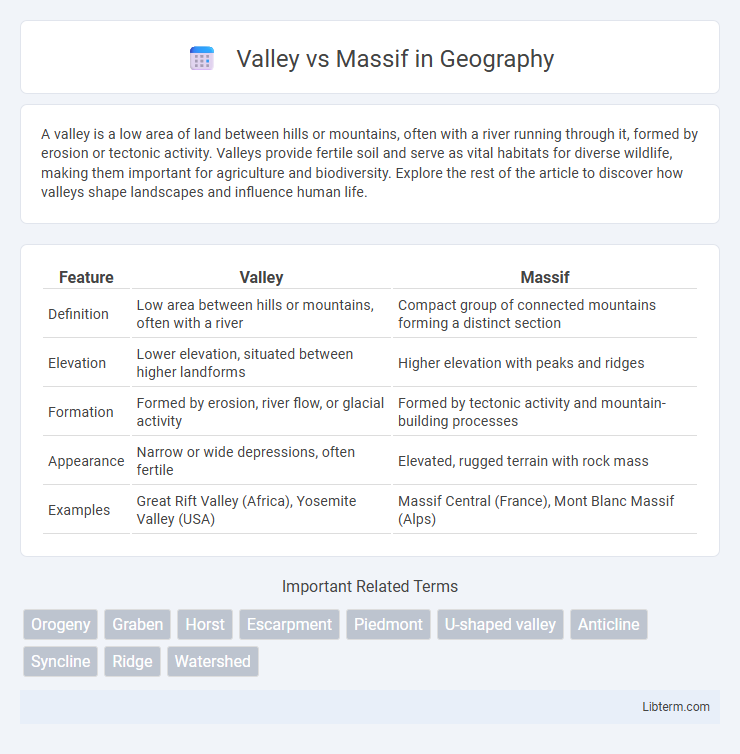A valley is a low area of land between hills or mountains, often with a river running through it, formed by erosion or tectonic activity. Valleys provide fertile soil and serve as vital habitats for diverse wildlife, making them important for agriculture and biodiversity. Explore the rest of the article to discover how valleys shape landscapes and influence human life.
Table of Comparison
| Feature | Valley | Massif |
|---|---|---|
| Definition | Low area between hills or mountains, often with a river | Compact group of connected mountains forming a distinct section |
| Elevation | Lower elevation, situated between higher landforms | Higher elevation with peaks and ridges |
| Formation | Formed by erosion, river flow, or glacial activity | Formed by tectonic activity and mountain-building processes |
| Appearance | Narrow or wide depressions, often fertile | Elevated, rugged terrain with rock mass |
| Examples | Great Rift Valley (Africa), Yosemite Valley (USA) | Massif Central (France), Mont Blanc Massif (Alps) |
Introduction to Valleys and Massifs
Valleys are elongated lowland areas situated between hills or mountains, typically formed by erosion from rivers or glaciers, serving as crucial corridors for ecosystems and human settlements. Massifs are large, compact groups of connected mountains or highlands, often formed by tectonic forces that uplift and consolidate rock strata into distinct blocks. Understanding the geological formation and structural differences between valleys and massifs provides insight into topographical diversity and landscape evolution.
Geological Formation of Valleys
Valleys are elongated low areas formed primarily through erosion by rivers, glaciers, or tectonic activity, often characterized by V-shaped or U-shaped cross-sections depending on the formation process. In contrast, massifs are large sections of the Earth's crust that have been uplifted or remain stable amid surrounding fault lines, typically consisting of resistant rock formations. Understanding the geological formation of valleys involves analyzing fluvial and glacial erosion mechanisms that carve out these depressions, which differ fundamentally from the tectonic and structural uplift responsible for massif formation.
Geological Formation of Massifs
Massifs are large, stable blocks of the Earth's crust that have been uplifted or remain intact amid surrounding regions that have undergone extensive deformation. They primarily form through tectonic processes such as crustal shortening and thickening during orogeny, resulting in rigid, high-relief structures composed of resistant rock types like granite and gneiss. Unlike valleys, which are erosion-formed depressions, massifs represent tectonically uplifted and structurally coherent features that expose deep-seated geological formations at the surface.
Key Differences Between Valleys and Massifs
Valleys are elongated low areas typically formed by erosion and often contain rivers or streams, whereas massifs are large, compact blocks of the Earth's crust, usually consisting of multiple mountain peaks. Valleys are characterized by their depth and slope, shaped by processes such as glacial or river erosion, while massifs are structural features resulting from tectonic forces and uplift. The main distinction lies in valleys being depressions between higher lands, contrasted with massifs as elevated and coherent geological structures.
Ecological Diversity: Valley vs Massif
Valleys often support higher ecological diversity due to their varied microclimates, water availability, and nutrient-rich soils that create ideal habitats for diverse plant and animal species. Massifs, characterized by their elevated, rocky terrain and harsher climatic conditions, tend to host specialized flora and fauna adapted to extreme environments, resulting in unique but often less species-rich ecosystems. The contrast between the lush, biodiverse ecosystems in valleys and the rugged, endemic-rich communities in massifs highlights important differences in ecological diversity driven by topography and climate.
Human Settlements and Cultural Influence
Valleys, characterized by fertile soil and access to water, often support dense human settlements and rich agricultural traditions shaping local cultures. Massifs, with their elevated terrain and natural barriers, host smaller, isolated communities that preserve distinct cultural identities and traditional practices. The contrast in topography between valleys and massifs significantly influences settlement patterns, economic activities, and cultural development.
Economic Importance of Valleys and Massifs
Valleys serve as crucial hubs for agriculture, transportation, and settlement due to their fertile soils and access to water resources, supporting diverse economies through farming, trade, and tourism industries. Massifs contribute economically by offering mineral resources, hydroelectric potential, and attracting tourism for activities like hiking and skiing, which generate local revenue and employment. Both valleys and massifs complement regional development by providing natural resources and recreational opportunities essential for sustainable economic growth.
Climate Variations in Valleys and Massifs
Valleys typically experience more pronounced climate variations due to their lower elevation, trapping cold air and creating microclimates that can sharply contrast with surrounding areas. In contrast, massifs, being large elevated landforms, tend to have more stable and cooler temperatures year-round, influenced by altitude and exposure to wind patterns. These climate differences significantly affect local vegetation, weather patterns, and human activities in both valleys and massifs.
Famous Examples Worldwide
The Grand Canyon in the United States exemplifies a famous valley carved by the Colorado River, showcasing deep gorges and rugged terrain. Mount Everest in the Himalayas represents a renowned massif, characterized by a compact group of connected mountains with towering peaks. Both formations highlight distinct geological processes that shape Earth's diverse landscapes globally.
Conclusion: Valley vs Massif Comparison
Valleys are elongated low areas formed by erosional processes, often featuring rivers, while massifs are compact mountain blocks formed by tectonic forces and characterized by complex rock structures. Valleys serve as vital pathways for ecosystems and human settlements, contrasting with massifs that contribute to rugged landscapes and biodiversity hotspots. Understanding the distinct geological formations and ecological roles of valleys and massifs enhances environmental management and land use planning.
Valley Infographic

 libterm.com
libterm.com